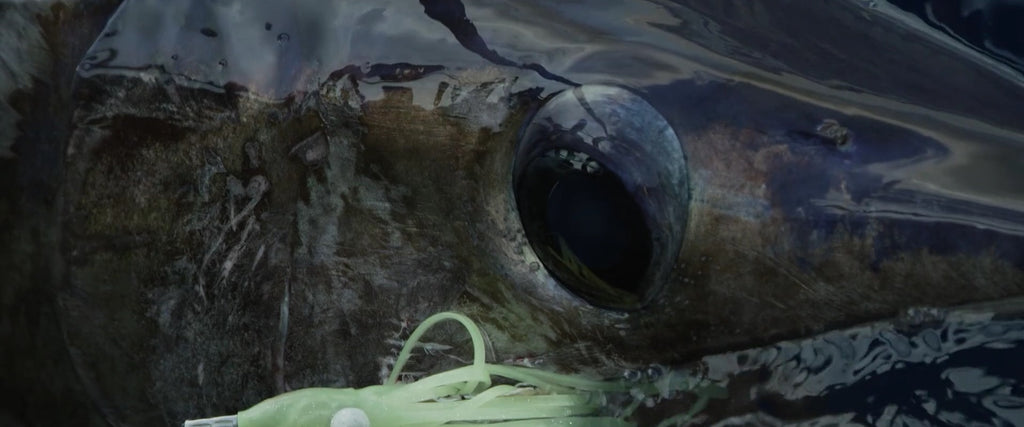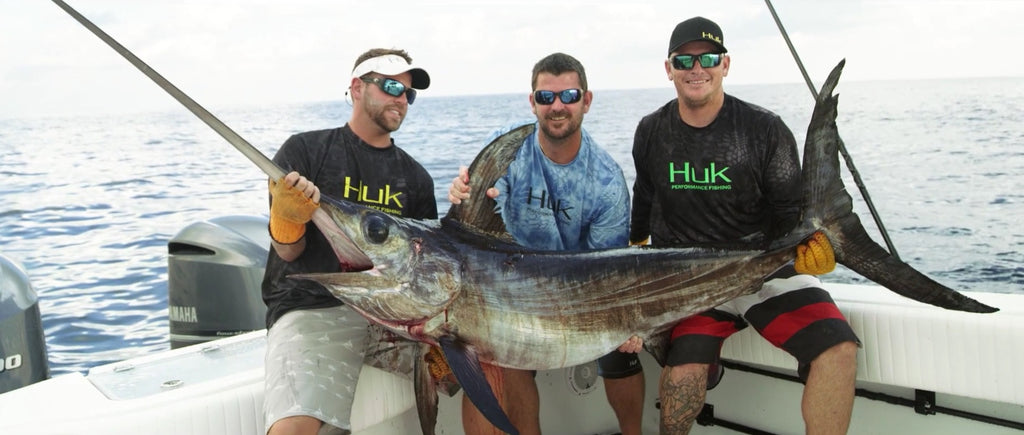Traditionally, swordfish are caught at night when they move from near the ocean floor to the surface to feed. But during the last decade or so, a niche group of fanatical anglers discovered that with the right gear and finely tuned techniques, swordfish can be targeted in broad daylight. If you’re ready to try this popular sport, here are some great daytime swordfishing tips, rigs and techniques!
Swordfish Fishing Season

Broadbill swordfish (xiphias gladius) can be caught during the daytime all year long throughout their expansive range which encompasses the entire Gulf Stream from the Mid-Atlantic to hot-spots off Southern Florida and into the Gulf of Mexico. There are some seasonal variations regarding fish numbers and size with the largest fish generally being caught in the fall and winter.
Swordfish Rigs & Bait

While every angler has his own preferences and variations, there is generally only one type of swordfish rig that is typically used—the deep drop rig. This rig is designed to get a bait down to the bottom of the ocean and keep it there while slowly trolling as efficiently as possible. This is crucial for daytime swordfishing, as you’ll want to target waters that are 2,000 feet deep or more!
- Rods: 7-foot bent-butt rods in the 80 to 100-pound class are standard for swordfishing. Due to the popularity of "day-timing," several manufacturers now make special rods that cater to the sport. These rods have very soft tips to detect subtle bites, ring guides for proper line management, and a single sealed roller guide at the tip.
- Reels: Since swordfishing requires fishing at extreme depths with heavy weights, beefy electronic reels with extra large spools are favored by most anglers. Look for something equipped with easy-to-use controls and powerful motors to make quick work of retrieving 12 pounds of lead from the depths.
- Line: 65 to 80-pound test solid core braided line is used for the main running line of a swordfish rig.
- Leaders: A 100 to 150-foot length of 200 to 250-pound test is spliced to the braided running line.
- Weight: Attached to the point where the braid meets the mono leader, a lead stick weight in the 7 to 12-pound range on a 30-foot dropper is clipped to the leader with a long-liner clip. The weight of the lead is generally determined by the strength of the water current—the stronger the current, the heavier the lead.
- Lights: A pair of lights are threaded onto the mono leader and held in place with rubber bands approximately 40 to 50 feet away from the bait. The lights indicate when the fish is nearing the surface during the fight.
- Swivel: A 600-pound class barrel swivel is crimped to the terminal end of the monofilament leader.
- Shock leader: To the swivel, a 5 to 7-foot length of 250 to 300-pound test monofilament leader material is attached. This shorter leader is used to tie on the rigged bait.
- Bait for swordfish: Durable sewn strip baits of mahi, blue runners, or small tuna species like bonito are ideal swordfish baits. Sewing on the baits makes them much more durable to stand up to repeated swordfish strikes and hits from other species during the troll. The strip baits are rigged with two inline closed-throat "J" hooks in 9/0 to 11/0 sizes. An octopus skirt is almost always added to the sewn bait to impart extra action and keep the bait swimming straight through the water.
Swordfishing Techniques & Strategies

The deep-drop swordfishing technique is performed by trolling over significant bottom structures like pinnacles and seamounts located in deep sea canyons throughout the Gulf Stream. High-quality boat electronics are essential and constant communication between captain and angler is required to keep the bait in the strike zone while trolling.
The Setup
Typically, a trolling pass for swordfish lasts anywhere from 30 to 45 minutes. Before the troll begins, the boat must be positioned far down current from the target structure to give the angler plenty of time to get the bait deep enough. Once in position, the captain moves the boat into the current at a speed of 1.5 to 1.8 knots.
The Drop
With the boat moving, the angler starts the fishing process by dropping the baited rig straight down into the water using the controls on the electric reel to manage speed. After all 150 feet of the monofilament leader is out, the lead stick weight is clipped on and the drop is continued.
When letting out the first 500 feet of braided line, the angler pauses for a few seconds every 100 feet to let any slack in the line work itself out. During this time, the captain regulates boat speed to maintain a vertical line angle into the water.
After 500 feet of line has gone out, the bait is allowed to freefall to the bottom. As soon as the angler feels the weight hit the bottom, it is reeled into the "strike zone"—anywhere from 40 to 100 feet off the bottom.

The Troll
Throughout the trolling pass, the captain and angler are communicating constantly, making adjustments in boat speed and weight depth to keep the bait in the strike zone. The captain calls out structures that are coming up so the angler can reel in or let line out accordingly. Then the swordfishing strategy becomes a game of waiting and watching, staying tuned into the rod tip for signs of a strike.
The Strike
During the troll, the rod tip flexes up and down with the rhythm of the boat. With experience and practice, the swordfish angler learns how to "sync up" with the rod movement in order to detect the faintest sign of a bite. Many times, a strike will come as a series of quick taps. Other times it will be an obvious slam. Swordfish are notorious for chasing a bait and hitting it several times before committing, but there are a few actions an angler can take to entice a solid bite.
When a fish strikes, one option is to let the weight free-fall to the bottom. Ideally, this action triggers the swordfish to chase the bait. Once the bait hits the bottom, the angler reels the line back into the strike zone depth—40 to 100 feet—at which point the hook should be set.

With the fish hooked, the fighting duties are delegated to the electronic reel. The best reels have an auto mode that maintains perfect tension on the line, letting the fish pull drag when needed.
After all the braided line has been regained and the monofilament leader is at the reel tip, the weight is unclipped from the line to finish reeling in. As soon as the swordfish is at the surface, a crew member thrusts a harpoon into the fish and a gaff is used to heave it onto the deck.
Part of the allure of daytime swordfishing is that you never know what's on the other end of your line. It could be a small broadbill, which is still worth celebrating, or it could be a 500-pounder. Either way, as soon as that fish hits the deck and photos are taken, it gets iced down to be enjoyed back on shore as the freshest swordfish steaks imaginable.
Head Out With The Right Swordfishing Gear

Be warned that daytime swordfishing is highly addictive. It gets under your skin. You'll want to be out in the Gulf Stream every spare second you have.
And when you do go out, you need to plan on staying out all day. Show up ready to handle a wide range of temperature fluctuations and sun conditions. Start with a moisture wicking and sun protective base layer like the Huk Kryptek Icon Long Sleeve. Then, add a mid-weight layer such as the Huk Fleece 1/4 Zip to stay warm on deck.
For the long, early morning runs to get off shore, the Huk Next Level All Weather Jacket will make the ride exponentially more enjoyable.
Daytime swordfishing isn't for everyone. But if you like to approach your fishing more like a chess match than a game of roulette, the strategies and techniques used to catch daytime swordfish will keep your mind sharp and take your angling skills to a new level. Get out there, and fish happy!



